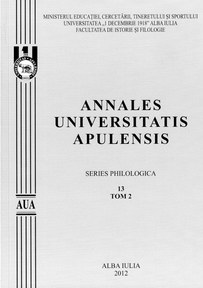PRACTICILE MAGICO-RITUALICE DIN MARAMUREŞ ÎNTRE TRADIŢIE ŞI MODERNITATE. MAGIA CUVÂNTULUI ŞI ANTROPOLOGIA VÂRSTELOR
Magic- Ritualic Practices between Tradition and Modernity in Maramureş. The Magic of the Word and the Anthropology of Ages
Author(s): Delia Anamaria DenciuţSubject(s): Customs / Folklore
Published by: Universitatea »1 Decembrie 1918« Alba Iulia
Keywords: magic; Maramureş; modernity; agrarian habit; spring; ritual; tradition
Summary/Abstract: Maramureş county is an archaic space, highly influenced by ancient beliefs and practices, by empirical knowledge, by ritual and sacred, by magic and symbolic actes. The present work is an attempt to highlight the specific interaction between the anthropology of ages, the magic of the word and the magico-ritualic practices which accompany an agrarian spring habit, Tânjaua, which can mainly be found within the Romanian community from the north-western Romania (the historical Maramureş). Tânjaua, the specific habit which celebrates the first man in the village who started ploughing the earth, represents a desecrated remainder of an ancient agrarian rite. Etymologically speaking, “tânjaua” is the wooden piece which binds together the separate parts of the peasant cart, that part which helps linking the oxen yoke. Nowadays, Tânjaua takes place in Hoteni village; it used to be known also as Hora teleguţii in other places, such as Vadul Izei, from Rona de Jos. Celebrating the most diligent householder means, first of all, finishing the ploughing and the sowing and it also implies the presence of fundamental and secondary functions. On the other side, this celebration shows the semantic unity and the wide spread of the habit all over the country (Lăpuş county, Maramureş county, Olt county, etc.). The regional names attest the spread of this agrarian habit: Bricelatul, Boii Sângiorzului, Căruţul, Craiul Gheo’, Craiul Nou, Craii de la Mocod, Craiul Semănătorilor, Hora teleguţii, Înstruţatul Boului, Plugarul, Plugul, Tânjaua, Teleguţa, Udătoriul. Whatever ontological steps it may represent (childhood, puberty, youth, maturity, old ages), the anthropology of ages interacts with other specific categories, such as children’s games, love’s games, magical rituals. On the practical level of the real manifestation, we come across magical-symbolic practices which move freely between tradition and modernity: verbal magical practices (which use the good force of the magic word), non-verbal magical practices (the clean shirt worn by the man during plowing means the body’s cleaning and spiritual purity and it determines a wealthy crop) and syncretic practices which reunite the gesture, the language and the actual spoken word (for example, the stop of the procession in front of the Sun, in a semi-circle reminds Mithra’s cult; the three-times surrounding of the land implies the circle, the protection due to the Sun invocation –in the old days- and to the Christian prayer in the present.).
Journal: Annales Universitatis Apulensis. Series Philologica
- Issue Year: 13/2012
- Issue No: 1
- Page Range: 125-140
- Page Count: 16
- Language: Romanian

